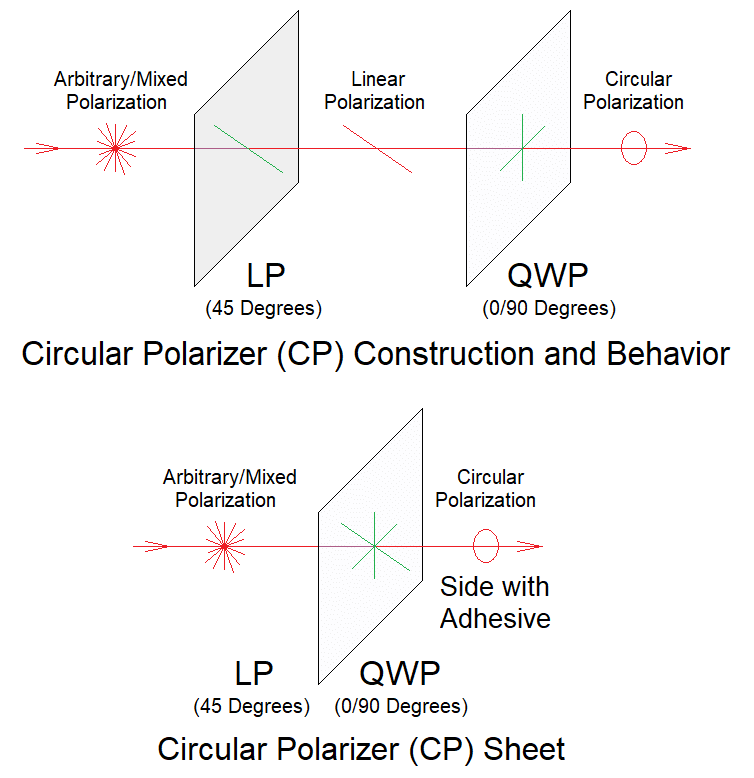Notes on Linear Polarizer and Circular Polarizer Sheets
Version 1.00 (21-Sep-2024)
Copyright © 1994-2024
Sam Goldwasser
--- All Rights Reserved ---
For contact info, please see the
Sci.Electronics.Repair FAQ
Email Links Page.
Reproduction of this document in whole or in part is permitted
if both of the following conditions are satisfied:
- This notice is included in its entirety at the beginning.
- There is no charge except to cover the costs of copying.
Introduction
This is basic information on the plastic sheet linear and circular polarizers
used in various kits. It is not intended to be a
treatise on polarization optics and applications; There is some specific
information in the various kit manuals and a Web search will turn
up way more than you want or need to know. ;-)
Both types are light gray and look the same upon casual inspection.
They are useful over most or all of the VIS wavelength range though most
of the applications relevant here use a red HeNe laser at 633 nm.
These sheet polarizers can be cut into any desired size with a pair of
scissors. For use with a typical photodiode, 5x5 mm or even less is large
enough. And the piece can be glued directly to the face of the photodiode.
Diagrams showing each type are shown below:
- Linear Polarizer (LP) sheet:
The polarization axis is parallel to one of the edges and orthogonal to the
other. It is symmetric in the sense that the input and output sides are
interchangeable subject to the restrictions discussed below with respect
to the protective film.

The polarization axis will probably not be labeled (but will be parallel
to one of the edges as noted). So if that matters,
testing will be required. This can use a linearly polarized laser if its
polarization axis is known or a linear camera lens polarizer which should
be labeled. Or view the oblique reflection of a light source like the
Sun from a diffuse non-metallic surface: The reflection will enhance
the polarization of reflected light parallel to the surface.
Of course the LP can be used at any angle, though +45 or -45 degrees would
be most common after 0 or 90 degrees.
- Circular Polarizer (CP) sheet:
This is functionally a sandwich of a linear polarizer oriented at +45 or
-45 degrees with a Quarter WavePlate (QWP) with its optical axes at
0/90 degrees.

For our purposes, the CP sheet can be used in several ways. Here are 2 of
them:
- As a linear polarizer to combine two orthogonal detected
polarization components from an interferometer as described above
except that the polarization axis is at plus or minus 45 degrees.
The output will be circular polarized but that is irrelevant since
the destination is likely a photodiode which is polarization-insensitive.
- As a QWP to shift the phase of one selected polarization component
by 90 degrees with respect to the other. In this case, the input is the
QWP-side and the output is the LP side. The output may go directly to a
photodiode.
These create a so-called Type III Quad-Sin-Cos detector.
There is a thin transparent protective film covering
both sides of the LP and CP sheets.
The film must be removed on either side where the polarization matters
as it is highly birefringent. One side of the sheet has an adhesive
backing. The protective film can be left in place on that side if the
polarization doesn't matter, as where the beam goes directly
to a photodiode. Or in that case it can be removed and the
LP or CP sheet can be stuck directly to the photodiode.
Or it can be stuck to something that is NOT birefringent like a glass
window or microscope cover slip. However, if the protective film is
removed from the sticky-side without replacing it with something,
dust may collect there.
To confirm if a specific sheet is LP or CP, identify the sticky side and
remove the protective film. Then rotate a known LP in front of it or pass
the beam from a linearly polarized
laser through it. The transmitted intensity will be fairly
constant for the CP-side of the CP sheet regardless of relative
orientation, but will go to nearly zero for the LP when the
polarization axes are orthogonal.
-- end V1.00 --

